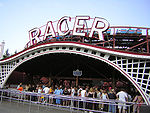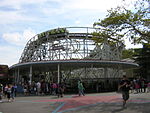Union Railroad Port Perry Bridge
1898 establishments in PennsylvaniaBridges completed in 1898Bridges in Allegheny County, PennsylvaniaBridges over the Monongahela RiverMetal bridges in the United States ... and 5 more
Pennsylvania bridge (structure) stubsRailroad bridges in PennsylvaniaTruss bridges in the United StatesU.S. SteelUnited States railway bridge stubs

The Union Railroad Port Perry Bridge is a truss bridge that carries the Pennsylvania Union Railroad across the Monongahela River between Duquesne, Pennsylvania and the former town site of Port Perry in North Versailles, Pennsylvania. Industrial pipelines adorn the bridge, as coke oven gas originating from U.S. Steel's Clairton Coke Works is conveyed to the company's Edgar Thomson Steel Works near the north end of the bridge for use as fuel. Union Railroad is owned and operated by Transtar, Inc., a subsidiary of U.S. Steel.
Excerpt from the Wikipedia article Union Railroad Port Perry Bridge (License: CC BY-SA 3.0, Authors, Images).Union Railroad Port Perry Bridge
Great Allegheny Passage,
Geographical coordinates (GPS) Address External links Nearby Places Show on map
Geographical coordinates (GPS)
| Latitude | Longitude |
|---|---|
| N 40.388 ° | E -79.8522 ° |
Address
Union Railroad Port Perry Bridge
Great Allegheny Passage
15104
Pennsylvania, United States
Open on Google Maps











